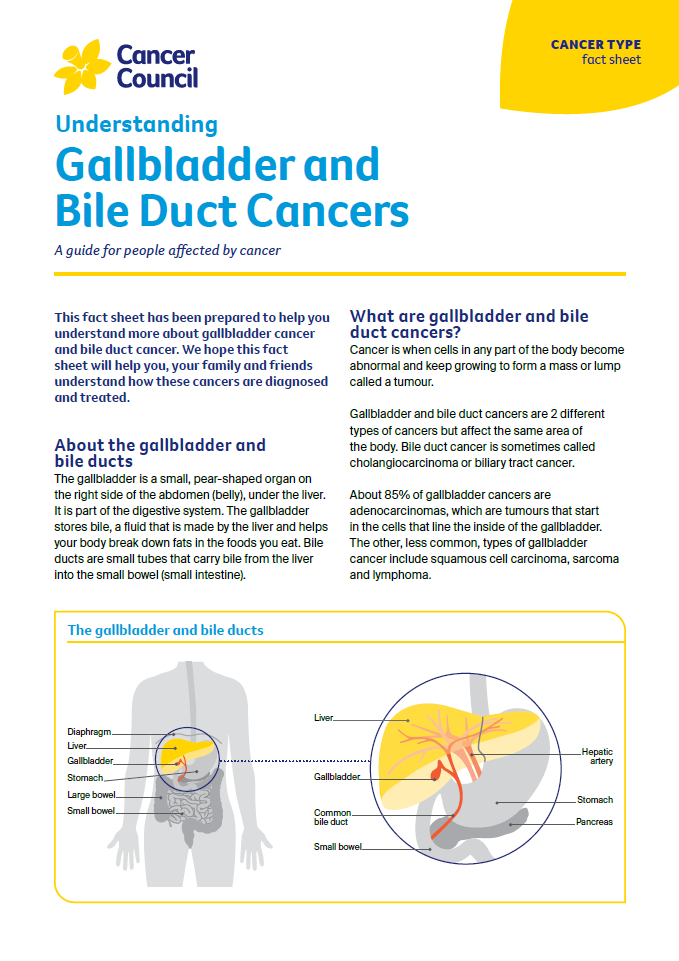- Home
- Gallbladder and bile duct cancers
- Diagnosis
Gallbladder and bile duct cancer diagnosis
Learn about the steps in the gallbladder and bile duct cancer diagnosis, from blood tests to ultrasound scans and their importance.
Learn more about:
The tests you may have
If your doctor thinks that you may have gallbladder or bile duct cancer, they will perform a physical examination and arrange some of the following tests:
| Blood tests | These may include a full blood count (to measure your white blood cells, red blood cells and platelets), liver function tests (to measure chemicals that are found or made in your liver) and tumour markers (to measure chemicals produced by cancer cells). |
| Ultrasound scan | For this scan, you will lie down. A health professional called a sonographer will spread gel over the affected part of your body, and move a small device over the area. Soundwaves are used to create pictures of the inside of your body. The ultrasound images are then projected onto a computer screen. An ultrasound is painless and takes about 15–20 minutes. |
| CT (computerised tomography) and/or MRI (magnetic resonance imaging) scans | Special machines are used to scan and create pictures of the inside of your body. During the scan you may have an injection of dye (called contrast) into one of your veins, which makes the pictures clearer. You will need to lie still on an examination table which slides into a large metal tube. A special type of MRI called magnetic resonance cholangiopancreatography (MRCP) shows the bile ducts in more detail. The scans are painless, though the MRI machine can be noisy. |
| Diagnostic laparoscopy | You will be given a general anaesthetic. The doctor will make small cuts in your abdomen. A thin tube with a camera on the end (laparoscope) will be inserted into your body so the doctor can see your gall bladder, bile ducts and other parts of your abdomen. |
| Cholangiography | This is an x-ray of the bile ducts to see if there is any narrowing or blockage. |
| ERCP (endoscopic retrograde cholangiopancreatography) | The doctor inserts a flexible tube with a camera on the end (endoscope) down your throat into your small intestine and into your bile duct while you are sedated. The camera takes images of your gut. |
| Biopsy | This is the removal of some tissue from the affected area for examination under a microscope. This can be done during a laparoscopy, a cholangiography or by a thin needle guided by ultrasound or CT scan. |
Staging
Staging describes how far the cancer has spread. Knowing the stage helps doctors plan the best treatment for you.
Gallbladder and bile duct cancers are staged using the TNM (tumour–nodes–metastasis) system, which indicates the size of the tumour, whether it has spread to nearby lymph nodes or if has spread to other parts of the body.
Staging gallbladder and bile duct cancers
The TMO system is used along with a number value from 0-IV.
| Stage 0 | Indicates the cancer is only in the place of origin and has not spread to nearby organs. |
| Stage I | Cancer cells have begun to spread to nearby tissue but are not deeply embedded. Lymph nodes are not affected. This stage is also known as early-stage cancer. |
| Stage II | The cancer is deeply embedded into nearby tissue. Lymph nodes may or may not be affected. This is called localised cancer. |
| Stage III | The cancer is larger and deeply embedded into surrounding tissue and lymph nodes are usually affected. This is also called localised cancer. |
| Stage IV | The cancer has spread to other parts of the body. This is known as advanced or metastatic cancer. |
Finding a specialist
Rare Cancers Australia have a directory of health professionals and cancer services across Australia.
When I heard the word cancer, my mind went completely blank. I was crying so hard I didn’t hear a word the doctor said after that. After a few days I started to think more clearly again.
Esther
Find information on coping with a cancer diagnosis in Arabic, Greek, Simplified and Traditional Chinese, and Vietnamese.
→ READ MORE: Gallbladder and bile duct treatment
Podcast: Tests and Cancer
Listen to more episodes of our podcast for people affected by cancer
Dr Corina Behrenbruch, Colorectal Surgeon, St Vincent’s Hospital Fitzroy, Peter MacCallum Cancer Centre, and The University of Melbourne, VIC; Dr Prasad Cooray, Medical Oncologist and Clinical Lecturer – The University of Melbourne Department of Surgery, Austin Health, VIC; Prof Jacob George, The University of Sydney and Head, Gastroenterology and Hepatology, Westmead Hospital and Western Sydney Local Health District, NSW; Dr Andrew Oar, Radiation Oncologist, Icon Cancer Centre, Gold Coast University Hospital, QLD; Chris Rivett, 13 11 20 Consultant, Cancer Council SA; Nicole Williams, HepatoPancreatoBiliary (HPB) Nurse Consultant, Southern Adelaide Local Health Network, SA.
View the Cancer Council NSW editorial policy.
